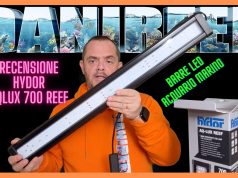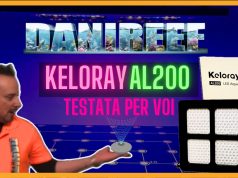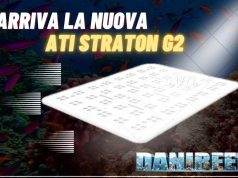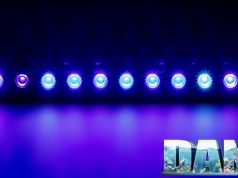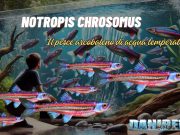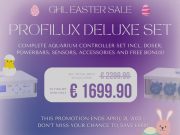How to value these numbers in aquarium?
This is a good question. At first we thought that we could transport these values to the aquarium tout-court. Than we filled the aquarium, insert the probe and redone the measurements. We fazed but, as we have already said in elsewhere, we’re going to talk about this in another article. Basically, while at 20 cm the result is practically the same, as we progressed, thanks to the glass and the water itself reflecting the light, we found even the double of the values measured in air. Obviously this isn’t a detail that can be standardized, so we think that our method of calculation is the most correct, and the best for the comparison of coverages of different ceiling lights.

Consumption
The measurement of the consumption was made possible thanks to the useful device RCE PM600 that can also measure the Cos(fi) (or power factor). The result is already given in watt.

Here above there’s the maximum power and below the Cos(fi).

The calculus of the absorbed current, that is the power, is the following one:
Ceiling light Orphek OR2 Reef Day Plus: 54,69 watt. Considering that at 17 cm the bars have at the middle 393 μmol m-2 s-1, let’s say, in perspective, that it will have a peak value of 7,18 μmol m-2 s-1 w-1 (PAR per watt). It’s hardly comparable with another ceiling light because it remains costant all over the length.
The consumption is slightly under the declared one, while the Cos(fi) is very close to 1, a perfect value.
The comparison with other ceiling lights on the market
Recently we started to use the new Apogee’s Quantum Meter MQ-510.
But considering the first celing lights we managed to test we can do an interesting comparison about their produced energy:
| Energy | Cost | Consumption | Energy/€ | Energy/w | |
| AI Hydra 32 HD at 17 cm | 560.185 | 430 | 90,50 | 1.303 | 6.190 |
| AI Hydra 32 HD at 37 cm | 563.232 | 430 | 90,50 | 1.310 | 6.224 |
| AI Hydra 32 HD at 57 cm | 462.614 | 430 | 90,50 | 1.076 | 5.112 |
| Aqamai LRM at 17 cm | 642.649 | 465 | 90,88 | 1.382 | 7.071 |
| Aqamai LRM at 37 cm | 721.676 | 465 | 90,88 | 1.552 | 7.941 |
| Aqamai LRM at 57 cm | 616.470 | 465 | 90,88 | 1.326 | 6.783 |
| Aqamai LRS at 17 cm | 275.881 | 289 | 47,59 | 955 | 5.797 |
| Aqamai LRS at 37 cm | 311.548 | 289 | 47,59 | 1.078 | 6.547 |
| Aqamai LRS at 57 cm | 254.283 | 289 | 47,59 | 880 | 5.343 |
| Cetus 2 at 17 cm | 409.993 | 215 | 60,68 | 1.906 | 6.756 |
| Cetus 2 at 37 cm | 290.866 | 215 | 60,68 | 1.353 | 4.793 |
| Cetus 2 at 57 cm | 173.651 | 215 | 60,68 | 807 | 2.861 |
| Orphek OR2 Reef Day Plus 120 cm at 17 cm | 255.277 | 180 | 54,69 | 1.418 | 4.667 |
| Orphek OR2 Reef Day Plus 120 cm at 37 cm | 232.564 | 180 | 54.69 | 1.292 | 4.252 |
| Orphek OR2 Reef Day Plus 120 cm at 57 cm | 225.142 | 180 | 54.69 | 1.251 | 4.117 |
| Philips CoralCare at 17 cm | 1.858.572 | 749 | 190,50 | 2.481 | 9.756 |
| Philips CoralCare at 37 cm | 1.340.533 | 749 | 190,50 | 1.790 | 7.037 |
| Philips CoralCare at 57 cm | 933.246 | 749 | 190,50 | 1.246 | 4.899 |

The energy produced by each watt stays costant in the different distances in the Orphek OR2. A very good and linear behavior of these LED bars. Now we only have to measure the behavior of other LED bars in order to compare the results.
Mantaining costs
The Orphek OR2 Reef Day Plus LED bars cost 180 dollars, plus the taxes we have to pay because there still isn’t a distributor here, but we have to consider the change of currency so, more or less, it’s the same price, that is 180 euro. The shipping is included.
The absorbed power is 54,69 watt, so the relationship cost/watt is about 3,3 euro per watt. In order to do a comparison with the other ceiling lights we had in our hands you can consult the following chart:
| Ceiling light | Price | Consumption | Relationship euro per watt | References |
| Orphek OR2 Reef Day Plus | 180 dollars | 54,69 watt | 3,3 euro per watt | DaniReef LAB |
| Cetus 2 | 215 euro | 60,68 watt | 3,5 euro per watt | DaniReef LAB |
| Philips Coralcare 2019 | 749 euro | 190 watt | 3,9 euro per watt | DaniReef LAB |
| Maxspect Ethereal | 500 euro | 126 watt | 4,0 euro per watt | Italian test |
| Radion XR30w G2 PRO | 790 euro | 170 watt | 4,7 euro per watt | Italian review |
| AI Hydra 32 HD | 430 euro | 90,5 watt | 4,75 euro per watt | DaniReef LAB |
| Radion XR30w G4 PRO | 915 euro | 190 watt | 4,84 euro per watt | Italian article |
| OceanLed Sunrise 600 | 870 euro | 180 watt | 4,8 euro per watt | Italian test |
| Orphek Atlantik V4 | 1099 euro | 226 watt | 4,9 euro per watt | Test |
| Radion XR30w G2 | 690 euro | 140 watt | 4,9 euro per watt | Italian review |
| Radion XR30w G4 | 760 euro | 150 watt | 5,1 euro per watt | Italian article |
| Aqamai LRM | 465 euro | 87,5 watt | 5,1 euro per watt | DaniReef LAB |
| Zetlight UFO ZE-8000 | 500 euro | 91,5 watt | 5,5 euro per watt | Test |
| Aqamai LRS | 289 euro | 47,59 watt | 6,1 euro per watt | DaniReef LAB |
| CEAB Slide & Led | 2.700 euro | 275 watt | 9,8 euro per watt | Review |
| Sicce GNC 466 | 1.592 euro | 120 watt | 13,3 euro per watt | Italian review |

The celing light is excellently built, solid and very well assembled. I really like extruded profiles as well as the refinement. It’s very easy to use and you can combine more bars in order to obtain the power you want. Considering that we’re talking about a LED bar the comparison with other ceiling light is very pitiful. But if you consider the total amount of energy you can have the full picture, because the light has to be summed. So the bars are perfect for any coral, you only have to combine an higher number of models. Do you want to double the PAR? Use two bars. Or quadruple? Use four, and so on. The cost per watt is very low, the lowest we’ve ever recorded, while before saying anything about the PAR per watt we should have more bars.

Questions and comments, as always, are very welcomed.








